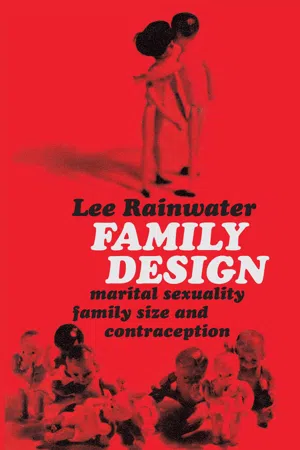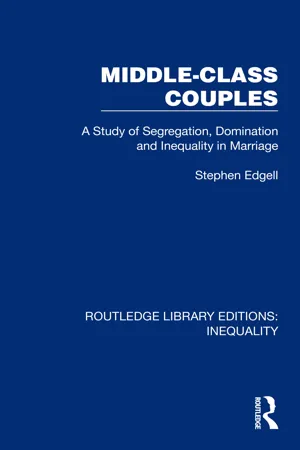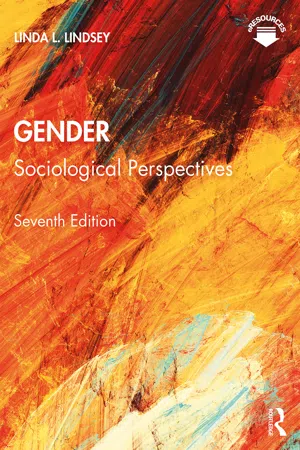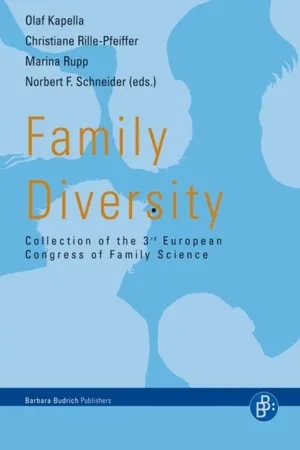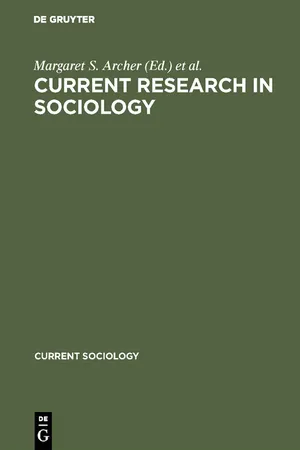Social Sciences
Conjugal Roles
Conjugal roles refer to the division of tasks and responsibilities within a marriage or partnership. These roles are often influenced by societal norms and expectations, and can encompass various aspects such as household chores, childcare, and financial management. The concept of conjugal roles has evolved over time, with modern perspectives emphasizing more equitable and flexible arrangements between partners.
Written by Perlego with AI-assistance
Related key terms
1 of 5
6 Key excerpts on "Conjugal Roles"
- eBook - ePub
Family Design
Marital Sexuality, Family Size, and Contraception
- Lee Rainwater(Author)
- 2017(Publication Date)
- Routledge(Publisher)
2 Social class and conjugal role-relationshipsCONJUGAL LIFE is a highly variegated and complex experience, and each of its aspects can be examined in great detail; only a careful evaluation of the many aspects of family interaction can present a really full and valid picture of family life. Noting that “the general functional problems facing the family are analogous to those facing the society as a whole,” Bell and Vogel (1960:19ff.) delineate four broad functional problems of activity within the nuclear family: (1) task performance, (2) family leadership, (3) integration and solidarity, and (4) pattern maintainence. Hess and Handel (1959:4) outline five overlapping major processes that “give shape to the flux of family life”: (1) establishing a pattern of separateness and connectedness, (2) establishing a satisfactory congruence of images through the exchange of suitable testimony, (3) evolving modes of interaction into central family concerns or theses, (4) establishing the boundaries of the family’s world of experience, and (5) dealing with significant biosocial issues of family life. Studying total families with these kinds of questions in mind is obviously a large order and beyond the scope and practical requirements of the present study.Conjugal role-relationships
However, one central characteristic of families which differentiates them from each other and has important consequences for their actions lies in the nature of the role-relationship between husband and wife—their typical ways of organizing the performance of tasks, their reciprocal expectations, their characteristic ways of communicating, and the kind of solidarity that exists between them. We will take the concept of conjugal role-relationship as central in our characterization of the family life of the couples studied. We will use it to organize our presentation in this chapter of variations in marital relations from class to class, and in later chapters to shed light on the psychosocial background of large and small family preferences, effective and ineffective contraceptive practice, and choice of contraceptive method. - eBook - ePub
Middle-Class Couples
A Study of Segregation, Domination and Inequality in Marriage
- Stephen Edgell(Author)
- 2023(Publication Date)
- Routledge(Publisher)
Chapter 2 The Sociology of Conjugal Roles and the Problem of Marital EqualityThere have been many attempts to describe the patterning of Conjugal Roles (Hammond and Oeser, 1954 ; Burgess, Locke and Thomes, 1963 ; Blood and Wolfe, 1960 ; Christensen, 1964 ). One of the most influential contributions is the work of Bott (1971 ), who studied twenty London families and collected data on four main areas of family life: housework, child-care, decision-making and leisure interests and activities, including contact with relatives, friends and neighbours. After trying to work with various classificatory schemes, Bott settled on the distinction between segregated conjugal role relationships and joint conjugal role relationships. The former refers to ‘a relationship in which complementary and independent types of organisation predominate. Husband and wife have a clear differentiation of tasks and a considerable number of separate interests and activities. They have a clearly defined division of labour into male tasks and female tasks. They expect to have different leisure pursuits, and the husband has his friends outside the home and the wife has hers’ (Bott, 1971 , p. 53). In contrast, a joint conjugal role relationship refers to ‘a relationship in which joint organisation is relatively predominant. Husband and wife expect to carry out many activities together with a minimum of task differentiation and separation of interests. They not only plan the affairs of the family together but also exchange many household tasks and spend much of their leisure time together’ (ibid., pp. 53-4).For the moment I am not concerned with the explanation of the patterning of Conjugal Roles, but with the meaning(s) attached to the concepts ‘joint’ and ‘segregated’. Bott herself was essentially concerned with the expectations couples expressed regarding the organisation of familial activities, although role performance and an authority dimension are also alluded to on occasions.1 More critically, although Bott found complementary, independent and joint conjugal role organisation in all the families she studied, she classified each couple in her sample according to the predominant pattern of conjugal role segregation. Subsequent research has suggested that activities tend to be organised differently in different spheres and therefore it is doubtful whether ‘jointness’ or ‘segregation’ refer to general characteristics of marriage (Piatt, 1969 ; Harrell-Bond, 1969 - eBook - PDF
Gender
Sociological Perspectives
- Linda L. Lindsey(Author)
- 2020(Publication Date)
- Routledge(Publisher)
As we saw from the census classifications, the definition of a family is not written in stone. It shifts with the broader social changes going on outside the family. These shifts show up in how people are labeled. Children of unmarried parents are unlikely to be referred to as “illegitimate,” for example. Symbolic interactionists specifically focus on how couples take on family roles that become traditionally gendered, such as housework, even when they desire egalitarian marriages. The definitions of what a man and a woman are supposed to do in the home are powerful and are reinforced every time family roles are carried out. However, because fam-ilies negotiate these definitions in the context of their own homes, the roles may change to what a couple wants rather than what they currently have. Marital satisfaction is determined by the perception of marriage and family roles. Men and women react to marriage differently according to these roles. Most married couples say that they are happy in their marriages, but males express slightly higher levels of happiness than females. Research using a wider range of diverse samples and measurement techniques, shows this slight difference favoring males in marital satisfaction is declining. Over time mar-ital tension (dissatisfaction) tends to increase for both wives and husbands, but it is higher for husbands (Jackson et al., 2014; Birditt et al., 2017; McCoy, et al., 2017). A key factor in marital satisfaction is the extent to which a couple agrees on expectations regarding tra-ditional gender roles. Marital quality decreases when a couple holds conflicting views, such as how spending decisions should be made or how children should be disciplined. When Gendered Love, Marriage, and Emergent Lifestyles 283 wives adopt less traditional gender role attitudes (I’ll decide how to spend my own income; women need time away from their families), the couple’s perceived marital quality goes down. - Available until 15 Jan |Learn more
Family Diversity
Collection of the 3rd European Congress of Family Science
- Olaf Kapella, Christiane Rille-Pfeiffer, Marina Rupp, Norbert F. Schneider, Olaf Kapella, Christiane Rille-Pfeiffer, Marina Rupp, Norbert F. Schneider(Authors)
- 2010(Publication Date)
- Verlag Barbara Budrich(Publisher)
Due, i.a., to the structural lag, such work cannot be performed solely by way of policy analysis nor by measuring attitudes towards sex/gender roles, quite apart from the fact that we currently have no tools (except those for measuring attitudes) that would allow us to map the sex/gender role norms in a way appropriate for today. The round of questions endlessly repeated by all the major surveys (“A husband’s job is to earn money; a wife’s job is to look after the home and family – ISSP), their gender bias (e.g. asking primarily about mothers’ – not fathers’ – roles): all this illustrates that the empirical data by which we believe we measure changes in sex/gender roles have in actual fact remained concep-tually stuck in the 1950s 5 . It would be highly desirable to obtain more differentiated map-pings of the roles of males and fathers in the family. Reading Parsons’ Age and sex in the social structure of the United States today, we can be sure that virtually all dimensions of the sex role concept sketched by him have been affected by change. Yet this does not necessarily mean that all these dimensions have changed symmetrically and simultaneously over time. Based on my own research findings and those of my colleagues, it is clear that, to name but one example, what is ex-pected of a husband or wife (or partner) varies considerably not just depending on the so-cial context but also across the different phases of the life course (Grunow et al. 2007). We need to develop a set of theoretical tools that conceptualises female and male roles (provided we want to retain the role concept) more adequately for our times. One key component of such a concept would be a dynamic analysis of institutions such as has been proposed by Helga Krüger and others: what do institutions across the life course – the law, the school system, the job training system, etc. - eBook - PDF
- Liz Steel, Warren Kidd, Anne Brown(Authors)
- 2012(Publication Date)
- Bloomsbury Academic(Publisher)
Exercise 7.6 When studying the evidence from various researchers on changes in Conjugal Roles, An E you may have reflected on the way things are organized in your own home. This exer-cise requires you to conduct a short quiz so that you can apply some of the relevant questions to your own experience. Copy out and complete the table below, which lists the responsibilities likely to be found in most homes. Your first task is to decide who would have been assigned each responsibility in the past, in a situation of clearly segregated Conjugal Roles. When you have decided this, perhaps as a group, you then need individually to say who is now responsible in each case in your own home. Some of the examples may not apply to your home – for example, there may not be a baby or a small child, but you might be able to find out what happened when there was. Similarly, a responsibility may be taken by a son or daughter rather than a parent – in this case the important question to ask is, is it one specific gender? Responsibility Traditionally taken by Taken in my home today by Score Washing up Replacing a fuse Ironing Mowing the lawn (or similar) Dusting Cooking family meals Climbing a ladder to an upper window Making beds Decorating Shopping for family groceries Unblocking the sink Family washing Looking after a sick child Bathing children/baby 122 The Family Carrying out routine checks on car Changing nappies Driving the car on family outings (or similar) Paying bills Answering the door late at night Booking holidays Scoring Allocate one point for every responsibility that has become a joint one in your home. The highest possible total score is 20 for the highest degree of ‘jointness’; the lowest score possible is 0, which indicates the highest degree of role segrega-tion. Compare the individual answers within your group or class. Can you detect any patterns? Evaluation You should now spend five minutes evaluating this quiz: 1. - eBook - PDF
Current research in sociology
Published on the occasion of the VIIIth World Congress of Sociology, Toronto, Canada, August 18–24, 1974
- Margaret S. Archer, 1974, Toronto> World Congress of Sociology World Congress of Sociology <8(Authors)
- 2018(Publication Date)
- De Gruyter Mouton(Publisher)
10. SOCIOLOGY OF SEX ROLES Changing sex roles: A review of sociological research developments and needs CYNTHIA FUCHS EPSTEIN Queens College of the City University of New York INTRODUCTION Although sex-role research is not a new field, it has emerged from a step-child position as a subfield of family sociology and has gained an in-dependent focus, capturing the imagination and attention of many scholars, women scholars in particular. 1 However, the spread of topics which could legitimately come under the heading of sex-role research is almost limitless, for men and women are actors in all social situations and social systems. Thus, although the study could include changing roles of men and women in micro and macro political, economic, and religious spheres as well as the cultural sector of the arts and literature, certain spheres of inquiry and certain issues have been emphasized in the past, and continue today to engage much re-search interest. Overarching all spheres is the fact that the changing sex roles of women have received more attention than those of men. Furthermore, the study of changing sex roles of both sexes, but women, in particular, has been explored in the context of social problem oriented research and deviance, rather than normality. Since sex-role research has focused on women's roles, emphasis has centered on the sex-division of roles in the family and the interplay be-tween women's family roles and their occupational roles. 1. For an excellent review of research in this area from a different perspective, see Arlie Russell Hochschild [49]*. Janet Giele [39] has also done an interesting account including an historical section. * The numbers between brackets refer to the Bibliography at the end of this article. 284 Sociology of sex roles Within the last year or two there has been a considerable attempt to broaden the inquiry of sex-role differentiation in almost all major academ-ic disciplines.
Index pages curate the most relevant extracts from our library of academic textbooks. They’ve been created using an in-house natural language model (NLM), each adding context and meaning to key research topics.
